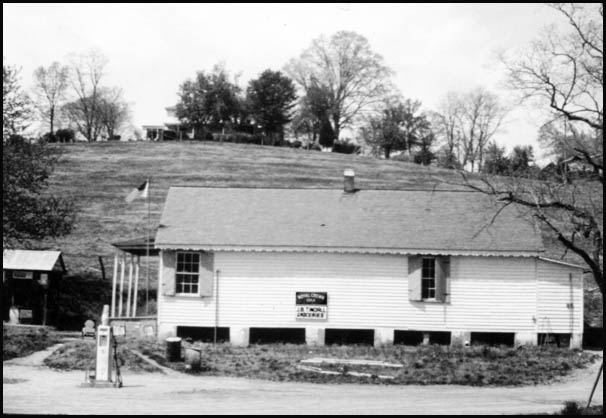

  |
|

|
Name: J.B. Tindall's Groceries Date: ca. 1950 Image Number: JT04cdJT01
This country store sold dry goods, groceries, pills, baking soda and sugar in barrels, clothes, hardware, shoes, kerosene oil, and fresh produce with customers across the river in Buckingham and the surrounding Albemarle countryside. When the store's grocery shelves needed restocking, Tindall rode the train to Richmond and shopped at several wholesale houses there. He would get to Richmond about 8AM and catch the 5 PM train back to Hatton, a three hour ride away. Drummers also came to Hatton to take orders for dry goods and shoes; Tindall would measure men for suits and hand the drummer a suit order to be placed. Twice a year, the shoe salesman arrived via train from St. Louis, Missouri, to take shoe orders. The store also contained the Hatton Post Office for which Tindall was the appointed postmaster. Some customers came four times a week to pick up their mail; others, once a week on a trip that coincided with their need to buy groceries or other supplies. Tindall employed several young men to help with such store duties as taking orders or stocking shelves. Johnny Jones, a young black man, came to work for Tindall at age 15 and was of invaluable assistance. Johnny could not read, but he excelled at stocking grocery shelves by matching the labels. He also was extremely honest; if he found a piece of change on the floor, Johnny would put it on the cash register with the statement, "'Tain't mine!" One day a customer found a coin on Tindall's floor and started to put it in his pocket. Johnny saw him do it and said matter-of-factly, "Tain't yours!" Tindall's son, Jim, Jr., started helping his father at the store at an early age. As his school schedule permitted, Jim would accompany his father to Richmond to buy groceries for the store. Once as a young boy, Jim caught the measles in Richmond and, upon his return to Hatton, infected 12-14 school children at his nearby country school plus one set of parents. After Jim graduated from Scottsville High School, he returned to Hatton to work fulltime at the store, train station, and in his father's ferry and timber businesses.
When James Tindall, Sr., died unexpectedly in 1945, his son, Jim, Jr., took over management of J.B. Tindall's Groceries and became the Hatton postmaster. He ran both facilities until his retirement in February 1973. The top two photos are part of the James Benson Tindall, Jr. collection. James resides in Scottsville, Virginia, and is the son of James Benson Tindall, Jr., and Mary Alice (Tapscott) Tindall. The bottom photo is part of the Kathleen McNamara collection; Kathleen resides in Scottsville, Virginia. Copyright © 2018 by Scottsville Museum |
|
|
|
Museum
Archive
Business
Cemeteries
Church
Events
Floods
For Kids
Homes
Portraits
Postcards
School
Transportation
Civil War WWII Esmont Search Policy |
||||
|
Scottsville Museum · 290 Main Street · Scottsville, Virginia 24590 · 434-286-2247 www.avenue.org/smuseum · info@scottsvillemuseum.com Copyright © 2018 by Scottsville Museum |
||||